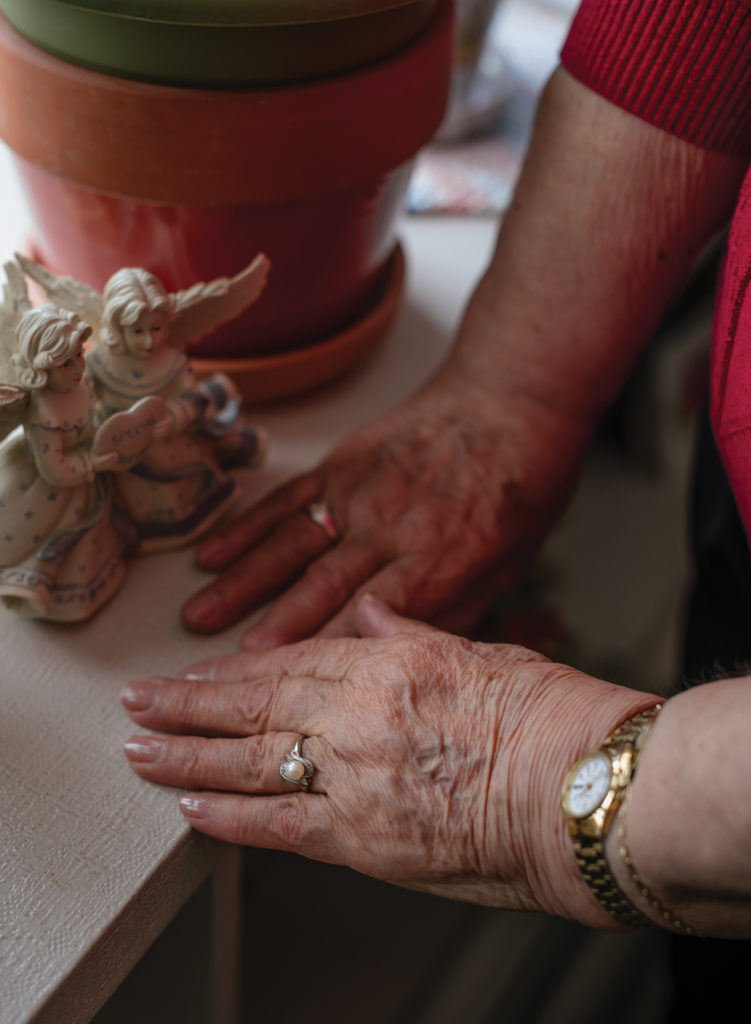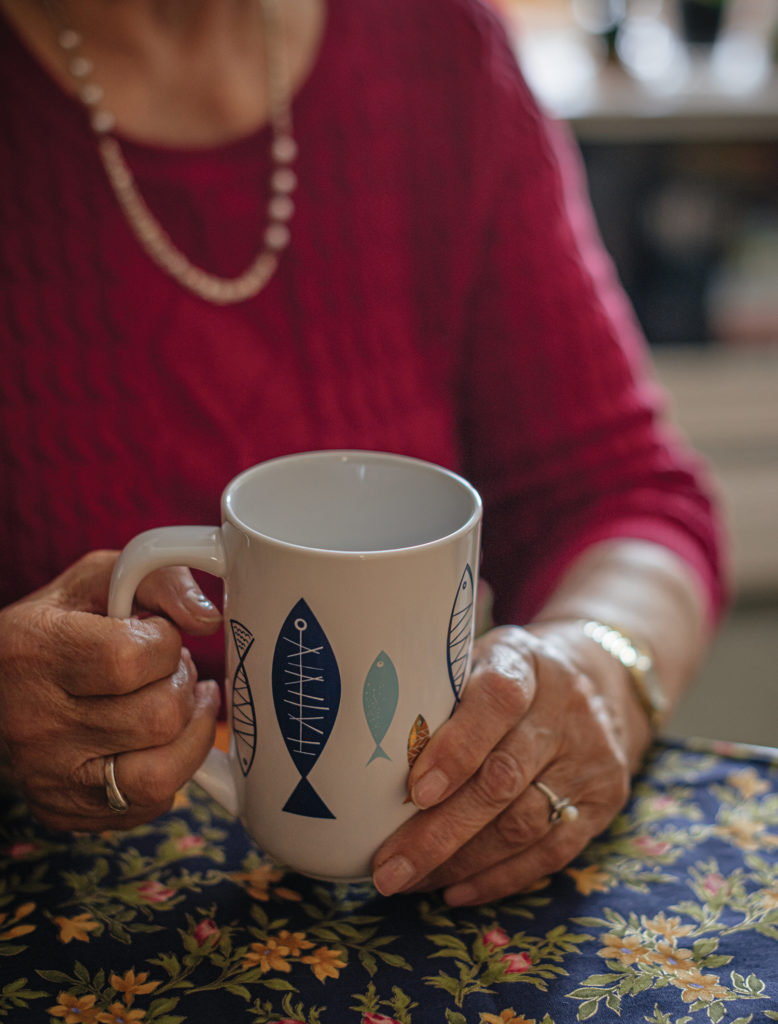July 5, 2020
She didn’t know how to leave her violent husband of 27 years. Until she just did it.
Last December, a 78-year-old woman hefted her walker onto a city bus and headed downtown to the Edmonton Community Foundation offices where she made a most unusual request.
Would it be possible, Mary asked, to go upstairs and see her old bedroom? Staff welcomed her inside, made tea and took Mary on a tour of Hilltop House, the century-old mansion that has been the Foundation’s home since 2005.
It was a decidedly different experience from her first arrival at the house on a December day 33 years earlier. Frightened and dazed, the middle-aged mother of two grown children had just made her “great escape,” fleeing her northeast Edmonton home and more than 27 years in an abusive marriage. She was promptly given a new name — Marg — and became the newest resident of Edmonton’s oldest halfway house for women.
Hilltop House wasn’t an easy place. But Mary was determined not to return to her old life. “I felt so strong.”

ACTION IS THE MAGIC WORD
Mary’s unannounced visit was sparked by a magazine article that detailed the storied history of the spectacular mansion at 9910 103 Street. Built in 1913, it had been the family home of John and Sophie McDougall until 1953, after which a variety of organizations were housed under its roof.
The Hilltop House women’s shelter was there from the late ’70s to its closure in 1987. But Alberta Social Services created the organization in 1965, locating it first in a building near the Legislature before eventually relocating it to the McDougall home.
By 1970 — the year Edmonton’s first official women’s shelter opened — Hilltop House had helped about 2,200 women from all walks of life, reported the Edmonton Journal in an article that began: “She is any woman with any problem that she can’t handle on her own, and she’s at the door of Hilltop House because she wants help … she wants to try to solve that problem. ”
A 1983 government document said women paid $8 a day for accommodation, practical help and counselling to help them develop life skills and regain self-respect.
Mary has kept the typewritten house rules, a handbook describing a facility that would nourish, protect and support its residents, but fully expected them to work hard to rebuild their lives.
“Action,” it says, “is the magic word at Hilltop House.”
THE GREAT ESCAPE
Mary was in high school when she met her husband-to-be at a Halloween dance in a central Alberta town. “He was very possessive then,” she says. “But I didn’t know. I really had no clue about how they’re jealous and possessive, hot-tempered.”
The abuse was rarely physical — “He didn’t do things where you’d see it”— but there were regular outbursts, irrational demands, tantrums, smashing things and threats. At a doctor’s visit on Dec. 15, 1986, she was urged to get out.
Mary didn’t know how to leave.
“I still went home and spent the night. Somehow I still stayed in the same bed with him. And that’s when he said, ‘I wish you were dead.’”
The next day, a friend helped her stuff clothing and other possessions into garbage bags and then called a cab to take Mary to the Royal Alexandra Hospital’s pastoral care unit.
“I would’ve been out there by the bus stop, waiting to go,” Mary says ruefully. “I didn’t know how to call a cab.”
At Hilltop House, her valuables were locked up to keep them safe from other residents. All the girls were expected to pitch in with chores. If you went out on an overnight pass, you weren’t guaranteed a bed on your return.
Mary flips through a sheaf of notebook pages, her careful handwriting filling both sides with journal entries that detailed her days at Hilltop House. Vacuuming. Window washing. The morning her glasses were gone.
“A terrible start to [the] day, cried a lot,” Mary reads. She looks up from her pages. “I cried a lot.”
But she also grew a lot, making purposeful decisions to rebuild her life. Within days, she’d set up a Blue Cross account and found a lawyer.
“On Dec. 18, I had an appointment with Manpower,” she says, amazement in her voice. “What was I thinking?”
Action had become the magic word.
On Jan. 10, 1987, 26 days after her arrival, she moved to an apartment in the west end. Six months later, she was divorced. After that, she began volunteering with seniors, which eventually became a full-time job at St. Michael’s Extended Care Centre.
“So thankful for all they have done,” she wrote about the Hilltop House staff in that day’s journal entry. She adds, “I guess because I felt safe. They saved me from him.”

FINDING A FUTURE
From the front porch of Hilltop House, you can see the Connors Hill building where Mary now lives. Her third-floor bedroom at the shelter is now the communication director’s office. And a firm friendship has grown between Mary and Anita Bauman, a former finance associate at Edmonton Community Foundation, who offered the tea and tour last December.
Bauman feels lucky to have spent an hourand-a-half with Mary that day. “It’s a hard subject matter,” says Bauman. “But she is so forthright in telling this story… She speaks wonderfully and you can’t help but be enthralled with her story. It just kind of left me weak in the knees.”
During the visit, Mary also learned about ECF’s work that, much like the Hilltop House shelter, is about building better lives for people in Edmonton.
In the past 20 years, the Foundation has allocated more than $2.9 million to city agencies that help women experiencing family violence, including the Edmonton Women’s Shelter, the Wings of Providence Society, Sage Seniors Association and the Alberta Council of Women’s Shelters (ACWS).
Mary also supports the ACWS and carefully reads through the letters they send her. The most recent letter included a troubling statistic: Last year, Alberta shelters turned away 23,247 women and children because they didn’t have room.
“They tell you to leave,” she says. “But where do you go?”
She’s also circled a piece of heartening news, that 96 per cent of women and seniors don’t return to their abuser after a stay at a shelter. Mary knows that she is fortunate to be among that group.
“I believe in angels,” she says, her gaze shifting to shelves that overflow with family photos and treasured mementos. “If you look around, I’ve got lots of angels.”